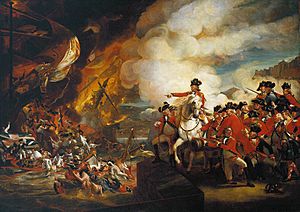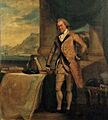Sir William Green, 1st Baronet facts for kids
Quick facts for kids
Sir
William Green
1st Baronet, of Marass, Kent
|
|
|---|---|

Sir William Green, 1st Baronet
|
|
| Born | 4 April 1725 |
| Died | 10 January 1811 (aged 85) Bifrons, near Canterbury, Kent, England |
| Buried |
Plumstead, Kent, England
|
| Allegiance | |
| Service/ |
British Army |
| Rank | General |
| Commands held | Royal Engineers |
| Battles/wars | Great Siege of Gibraltar |
| Relations | Adam Smith (uncle) |
General Sir William Green, 1st Baronet, (born April 4, 1725 – died January 10, 1811) was an important officer in the British Army. He was known for his engineering skills. He helped design and build many military structures, especially in Gibraltar.
Green received a special education in Scotland and then went to the Royal Military Academy in England. He became an engineer in the army in 1743. He served in Europe and Canada, moving up in the ranks as he gained experience.
Later, he became the chief engineer for Gibraltar in 1770. He designed many important military buildings there. He also came up with the idea for a special group of military builders called the Soldier Artificer Company. This group was the start of the Royal Sappers and Miners, who are still important today.
Green was the chief engineer during the Great Siege of Gibraltar (1779–1783). This was a very long and difficult battle. After the siege, he was honored with a special title called a baronetcy. He became the chief engineer of Great Britain in 1786 and retired in 1802.
Contents
Early Life and Family Connections
William Green was born on April 4, 1725. His parents were Fairbridge Green and Helen Smith. Interestingly, his mother, Helen, was the sister of Adam Smith. Adam Smith was a very famous writer and thinker. He wrote important books like The Theory of Moral Sentiments and An Inquiry into the Nature and Causes of the Wealth of Nations.
William Green married Miriam Watson on February 26, 1754. Miriam's father, Lieutenant Colonel Justly Watson, was also an engineer in the Royal Engineers. William and Miriam had several children. Their son, Justly Watson Green, also became an army officer.
Green's Military Journey

William Green started his military training very young. In 1737, he joined the Royal Military Academy in Woolwich, London. He became an engineer in 1743 and was first stationed in Portsmouth, England.
Green served in many battles across Europe. He fought in the Battle of Fontenoy in 1745 and saw action in France. He was even wounded and captured during the Battle of Val in 1747. After the British army left Europe, Green stayed to map out parts of the Netherlands.
In 1752, Green went to Newfoundland in Canada to check its defenses. Three years later, he became the chief engineer there. He also trained soldiers in military engineering in Halifax, Nova Scotia. Green took part in several battles in Canada, including the famous ones at Quebec and the Plains of Abraham in 1759.
In 1761, Green was sent to Gibraltar as a senior engineer. He quickly became a lieutenant colonel. He returned to England in 1769 to share his ideas for making Gibraltar's defenses stronger. His plans were approved, and he returned to Gibraltar in 1770 as the chief engineer. He even designed a hospital there in 1771.
Before 1772, civilian workers built military structures in Gibraltar. These workers could leave whenever they wanted, which caused problems for the army. William Green had a great idea: create a company of military builders. This new group, called the Soldier Artificer Company, was formed in 1772. They were trained artisans who worked for the military. This company was the start of the Royal Sappers and Miners, who are still a vital part of the British Army today. One of their first big projects was building the King's Bastion, which Green designed.
In 1777, Green was promoted to colonel. He went back to England to ask for more money to improve Gibraltar's defenses. He even met with the king! He returned to Gibraltar the next year with permission to continue his work.
The Great Siege of Gibraltar
Green played a very important role during the Great Siege of Gibraltar (1779–1783). This was a long and tough battle where Gibraltar was attacked by enemy forces. During the siege, Green was promoted to brigadier general. Sadly, his home was exposed to enemy fire, and his wife, Miriam, became ill after they moved to a shelter. She passed away in 1782.
Despite his personal loss, Green continued his work. In 1781, a battery (a place where cannons are set up) called the Queen's Battery was badly damaged. Green and his team rebuilt it completely overnight! He was promoted to major general later that year.
In 1782, he built the Great Siege Tunnels, including St. George's Hall. These tunnels were a clever way to move soldiers and cannons safely. During a massive attack on September 13, 1782, Green's kilns (special ovens) kept producing red-hot cannonballs. These hot shots were very effective against enemy ships. He also rebuilt the Orange Bastion while under constant attack. The siege finally ended in February 1783. Green left Gibraltar in June of that year, after serving there for 22 years.
After the siege, Green was honored with a baronetcy in 1786. This meant he received the title "Sir" and his family would inherit it. He was also appointed chief engineer of Great Britain that same year. He became president of the defense committee in 1788. Green continued to receive promotions, becoming a lieutenant general in 1793 and a full general in 1798. He retired in 1802. In 1790, he was elected a Fellow of the Royal Society, which is a very prestigious group of scientists.
Green's Lasting Impact

General Sir William Green passed away on January 10, 1811. He was buried in Plumstead, Kent. There is a special plaque in Plumstead Church to remember him. His son, Justly Watson Green, inherited his baronetcy, but the title ended when his son died without children.
Sir William Green is shown in famous paintings about the Great Siege of Gibraltar. One painting, The Defeat of the Floating Batteries at Gibraltar, September 1782 by John Singleton Copley, shows him standing near the governor. Another painting, The Siege of Gibraltar, 1782 by George Carter, also features him. A portrait of Green from around 1785 hangs in The Convent, which is the home of the Governor of Gibraltar.
A place in Gibraltar, Green's Lodge Battery, was named after him. This artillery battery was built in 1776 on the North Face of the Rock of Gibraltar. It was used during the Great Siege. Today, it is listed with the Gibraltar Heritage Trust. There is also a walking path called Green's Lodge Nature Trail in northern Gibraltar, named in his honor.
Images for kids
-
The Defeat of the Floating Batteries at Gibraltar, September 1782, by John Singleton Copley
-
William Green, Chief Engineer of Gibraltar; by George Carter
-
The Siege of Gibraltar, 1782, by George Carter






